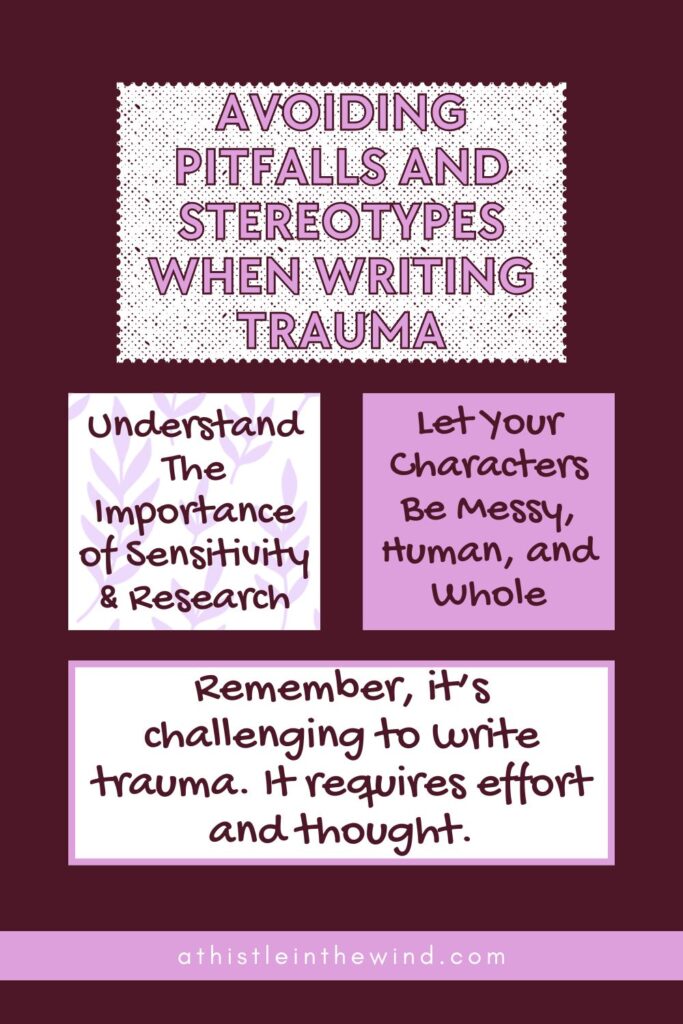On Writing Trauma: How to Do Justice to Your Story & Readers
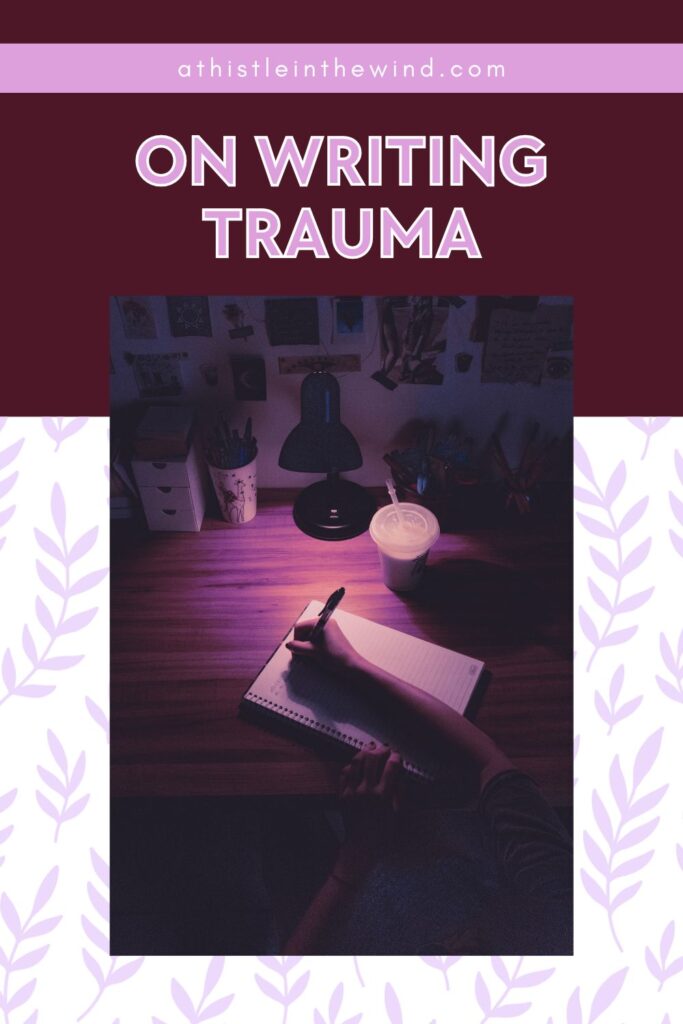
Okay, so this one’s a popular request. I’ve got many emails and comments under my post, On Writing Emotions to cover how to write trauma in fiction, so here we are. The reason this took me a while is because there’s a lot at stake here. You can easily fall into a Colleen Hoover-shaped rabbit hole where you’re romanticizing something that’s not a joke.
Of course, that doesn’t mean that you completely ignore the subject, but when you’re writing trauma, you need to be more intentional. When done right, it helps readers connect with your characters and fosters empathy around complex issues. When done wrong…I believe we have plenty of examples of that in popular fiction. And since this topic itself is quite heavy, I’d rather focus on how to write it in a way that adds depth and nuance to your story.
The stories we tell have a lot of power. They shape how we view ourselves and the world. So, let’s get started.
How to Approach Writing Trauma
Before we dive into how to write trauma well, let’s talk about how to approach it. Developing this is important because inaccurate, sensationalized, or careless portrayals can reinforce stereotypes, contribute to stigma, and even harm readers who have lived through similar experiences. Your goal isn’t just to add depth; it’s to create a truthful and respectful landscape of survival.
Understand the Trauma’s Deep Impact
Trauma, in its simplest description, is experiencing “too much, too soon.” It results from deeply distressing events that overwhelm a person’s ability to cope, leaving them feeling helpless or paralyzed. It’s important to note that trauma isn’t just a painful memory: it alters the structure and function of the human brain.
For instance, areas like the amygdala and the hippocampus both get hit. When a traumatic event occurs, the brain activates a neurochemical response designed for escape. This results in lasting changes to neuropsychology, manifesting in symptoms like anxiety, hyper-vigilance, emotional detachment, or PTSD.
Understanding that trauma fundamentally rewrites a person’s brain chemistry is essential for realistic character creation. I’ve read a lot of indie books where trauma wasn’t approached properly. And the writer just added misery on top of misery to the point where it was just…I had to put the book down.
Your characters don’t have to go through hell—everyone experiences things differently. What might be a bump in the road for me, might be something that could change another person’s life forever.
So, when you’re writing trauma, do remember your character’s background: who they are, where they come from—all of this can add emotional weight and complexity without making it seem like something done for the sake of the plot.
The Responsibility of the Narrative
For a long time, stories have offered what can only be called “dishonest endings,” where writers chose to show narrative comfort, rather than properly showing actual healing. Thankfully, a few popular series have started tackling it head-on. An example that comes to mind is Mockingjay by Suzanne Collins who properly depicts Katniss dealing with what happens after the revolution is done. Similarly—and trust me, I’m in awe too because I don’t like those books at all—Sarah J. Maas, in A Court of Mist and Fury, does actually show the aftermath of the first book and how it affects Feyre. Seriously, it was surprising for me that she managed to do it properly, considering how bad the entire series is.
It’s essential that your story (or its sequel) does address how a character is impacted by what they went through. Because if characters endure traumatic experiences without changing in response, that’s a red flag. Such stories can unintentionally reinforce the idea that ongoing trauma responses are a sign of weakness or are simply “unusual.”
A trauma-informed approach understands that fear and pain leave lasting fingerprints on the brain. It recognizes that hope and suffering are not mutually exclusive. A hopeful future must incorporate acknowledgment of harm done and make space for the ongoing effects of that harm. This is done extremely well in Mockingjay.
So, remember to resist the empty promise that catharsis and closure automatically cure trauma. Instead, you should treat the experience of suffering as morally neutral—a person who experiences suffering is not inherently good or bad because of it.
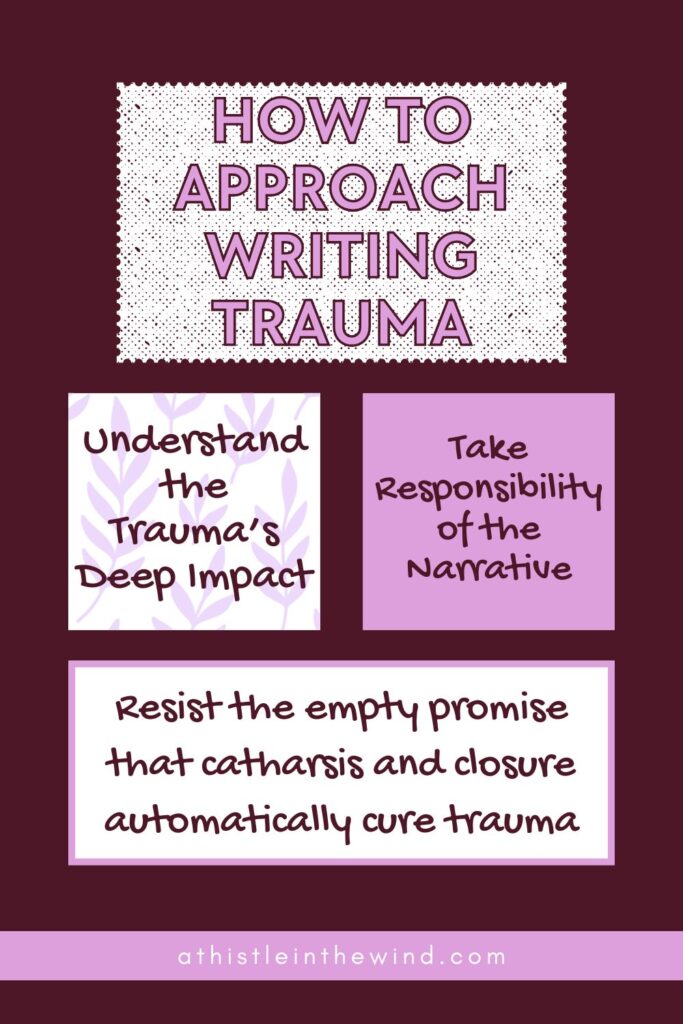
How to Write Trauma in Fiction: Showing the Internal War
Rule of thumb: when you’re writing trauma, don’t dwell on the why of the trauma. Instead, focus on the effects it has on the present. If you use trauma as a shortcut to character depth without showing the long arc of complexity and survival, it can fall flat. Trauma must inform how your character moves through the world, how they form relationships, and how they perceive safety or threat.
In my own book, the main character loses someone very close to her in the first chapter. This ends up clouding her judgement throughout the book. She’s avoiding dealing with this, of course—but you can see the impact of it. It doesn’t happen all the time, but it’s a reminder for readers that she’s only pretending to be fine. Without giving away any spoilers, it sets up the volcano that erupts in the climax of my story.
To authentically depict a character living with trauma or Post Traumatic Stress Disorder (PTSD), focus on these core techniques:
1. Don’t Overexpose the Trauma
Focus on showing the ongoing condition and the coping mechanisms used to control symptoms, rather than lengthy flashbacks to the event itself. In my book, I do this by never replaying the scene again. Instead, I use a couple of lines, different each time, to give readers a brief look into my character’s mind. It’s a moment’s lapse in control and that’s what you’re going for.
Your characters will probably be actively trying to avoid thinking about it because the resulting emotions and physical symptoms are deeply uncomfortable. Instead, show them trying to turn their mind off, perhaps by running five more laps than usual or seeking control proactively.
2. Show The War Going On Inside Your Character
When triggered, everything amps up as though an adrenaline rush has been forced upon the character and won’t stop. You don’t need a flashback to show this intense state. The mind is simultaneously ramping up the body and trying desperately to regain control of the physical response.
The character is at war with themselves, aware internally that they are being irrational and that there is no threat, yet they are unable to feel safe. Show them struggling to control, conceal, and minimize what others can see. In my book, I have my character do something rash, like ignoring good advice or guidance.
3. Trauma Is About Minimizing Triggers
People managing trauma will develop proactive, though not always healthy, strategies to manage their symptoms. These methods can be subtle or extreme. When a character is triggered, their survival instincts kick in, leaving them with simple choices: fight, flight, or freeze.
Determine your character’s primal goal in that moment—is it survival, safety, or escape?—and have them seek that goal out at all costs.
Strategies might include reciting a mantra to control thoughts, relying on a trusted person to watch their back in new or upsetting situations, or using grounding techniques where they consciously catalogue reasons why perceived threats won’t happen. Showing the slow removal of dependence on these management techniques is a powerful way to demonstrate character growth.
4. Give Them A Tell
Self-awareness is critical for management. The process often begins mentally with thoughts like, “I’m not safe. I’m not safe,” but it’s hard to catch this mental initiation. More often, the body tips off that the mind is racing. This self-awareness serves one purpose: to allow your characters to manage what they see coming.
Does your character have a physical tell they’ve trained themselves to watch for, such as blushing or sweating profusely, disproportionate to the environment? Let your character become increasingly self-aware throughout the story, recognizing the problematic thoughts that jumpstart the spiral. They will often want to hide these symptoms because they are aware of the stigma and that their actions make others uncomfortable. Show this awareness of the stigma, and importantly, let them fail from time to time.
5. Blindside Your Character
A trigger can strike at any point, even in a situation that has been completely fine a thousand times before. This unpredictable nature of trauma is a powerful device to save for a pivotal conflict. Show your character’s emotional wounds “bleeding all over the floor” and yet, have them keep going anyway. Show them growing stronger, learning to trust, and forgiving themselves, remembering that this process is messy, often involving two steps forward and one step back. Authentic stories rarely end neatly with the character feeling completely “cured.”
6. Master Deep Point of View and Inner Conflict
To truly bring trauma to life, you can utilize Deep Point of View (Deep POV), focusing on showing the character’s primary emotions through their physiology and internal dialogue. Secondary emotions can then be shown through spoken dialogue and outward actions.
Inner dialogue is a profound way to give readers direct access to the character’s internal struggles. It captures moments of intense anxiety, self-criticism, or hesitation that might be hidden outwardly. For instance, the thought, “Why am I reacting like this? It’s been years,” reveals the internal wrestling match and grounds their external behavior in emotional truth.
Trauma provides built-in internal conflict, as characters constantly wrestle with their past experiences and present challenges. If done well, these layers of internal conflict will do what trauma really does—it lingers, reshapes, and refuses to be boxed into a clean arc.
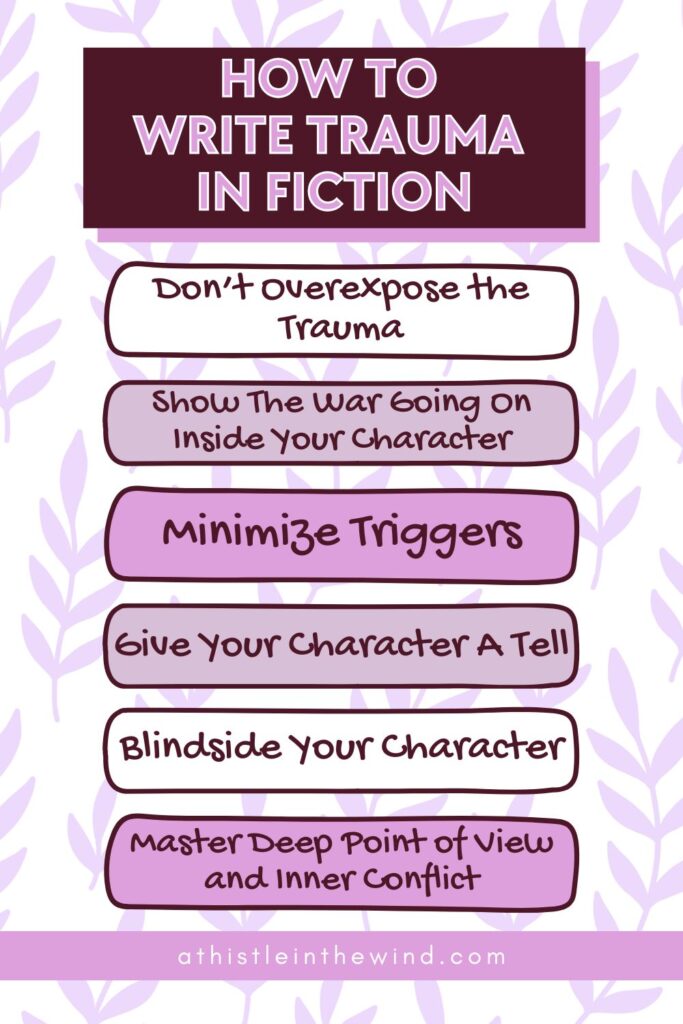
Writing Trauma Responsibly: Aftermaths, Coping, and Endings
Writing trauma requires intentional choices that decide whether a story feels exploitative or respectful. This means focusing on the long-term echoes of the trauma rather than the event itself.
1. Grounding the Aftermath, Not Just the Event
Instead of centering the traumatic event as the climax, focus intensely on the consequences and the ensuing silence. The real emotional truth often lies in the small moments: how a character avoids certain places, flinches at loud noises, or overcompensates in subtle ways.
When depicting reactions, subtlety is key. Avoid overwhelming the reader with excessive detail. Instead of describing every sensation of a panic attack, a brief mention of a racing heart or sudden tension can be enough to convey the emotional response.
Allowing the reader to infer the depth of the character’s experience by filling in the gaps respects their emotional space and maintains realism. By giving the reader the start of an event and then moving quickly to the aftermath, you save both the character and the reader from the full horror.
2. Handling Triggers and Coping Mechanisms
As established, a character’s past trauma shapes their present fears, desires, motivations, and behaviours. This provides a rich foundation for understanding why they might react strongly to certain triggers or yearn for safety.
For example, a character who suffered a traumatic betrayal might exhibit severe trust issues or become fiercely self-reliant, traits that drive their relationships and choices throughout the narrative.
Characters develop unique coping mechanisms, which may include positive responses like mindfulness, or more challenging ones like suppression, avoidance, or using humor to mask their pain.
A character might use humor as a shield, making light of difficult situations to avoid emotional confrontation. Survival instincts, such as hyper-vigilance, can make a character incredibly perceptive of potential threats, though this hyper-alertness also often leads to exhaustion or difficulty relaxing. Incorporating a mix of positive and negative coping strategies showcases the character’s resourcefulness, adaptability, and vulnerability.
Additionally, the character’s environment and relationships are powerful indicators of trauma’s effects. Settings or loud noises can act as triggers, hinting at their past without needing explicit backstory. A character might be guarded or distant with loved ones, struggling with trust, while a loyal pet might provide unconditional acceptance, acting as a safe emotional outlet.
3. Reimagining Endings
If an ending promises that catharsis will simultaneously heal trauma and provide closure, it is making a painful and empty promise. Instead, the work of living alongside trauma, and writing trauma-informed narratives, demands careful, thoughtful integration.
Healing, as a concept, often implies returning to an assumed baseline of well-being, but the self changes as a result of trauma. Rather than trying to fix or repair a wound that doesn’t need repair, we should approach the change as something that needs to be understood and accommodated.
Similarly, the notion of acceptance often falls short; trauma occurs when something happens that is inherently intolerable. Attempting to reframe the intolerable as tolerable misunderstands and disrespects the nature of the trauma.
True healing is messy and non-linear. It doesn’t mean the trauma disappears; it means the character learns how to live with it, not under it. Show how they re-engage with life—setting a boundary, trusting someone again, or laughing for the first time in weeks. Avoid narratives where characters are magically rewarded with healing because they were “good victims” or provided forgiveness. Instead, let them be whole, even when they are still in progress.
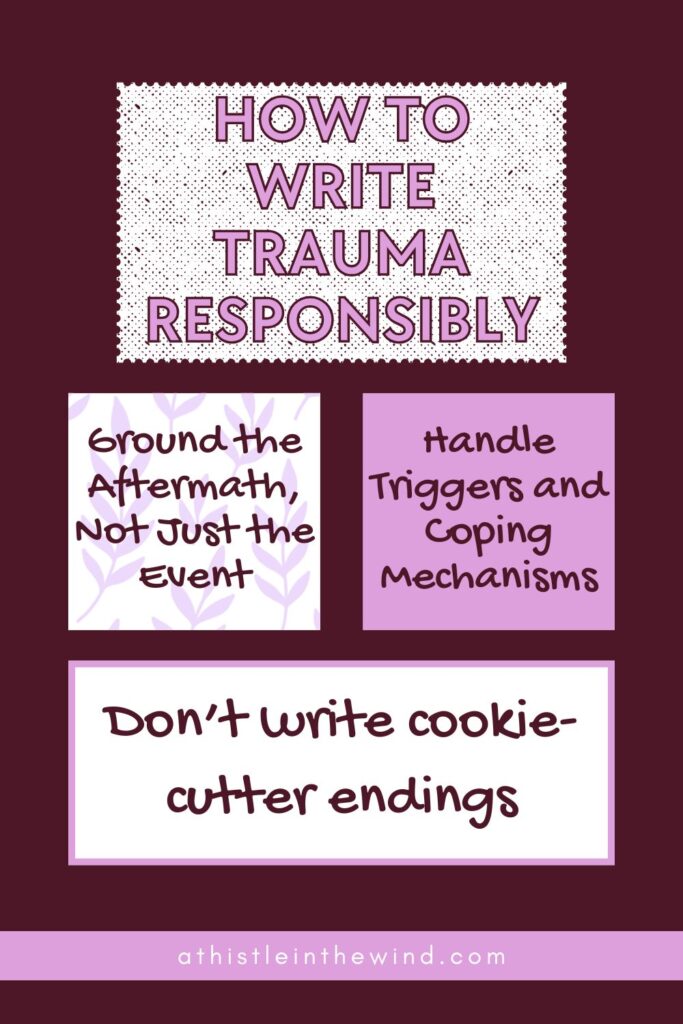
How to Protect Yourself and Your Reader
Writing about dark events or personal history can be hard. Even if you haven’t experienced the trauma you’re writing about, you’re going to be drawing inspiration from somewhere: other books, news articles and sometimes actual victims’ own retelling of what happened. This can affect your mental health.
I draw inspiration from what happens in my life as well—the part of my protagonist’s aunt’s death? That’s a direct inspiration from how I felt when my grandfather passed away during the pandemic and I was stuck in Turkey. Incidentally, I’d written this plot point before that event, but it’s actually my grandfather’s passing that brought this into focus in the story.
Create A Rhetorical Distance
To avoid putting the reader—or yourself—through overwhelming physical and emotional responses, it’s necessary to build rhetorical distance around traumatic or brutal scenes. Readers’ brains respond to vivid scenes as if they’re living through them. So, it can feel overwhelming.
Several techniques can create this necessary buffer:
- Change Perspectives: Switch the point of view character specifically to someone who is not enduring the pain. Tell the scene from the perspective of a dispassionate observer, like a detective reciting facts, a doctor, or a friend who cares but is not experiencing the event firsthand. For example, seeing a character’s accident from an outsider’s view (like an observer far away) makes the scene more humorous or distant, but experiencing it from the main character’s perspective activates the audience’s fear and chaos.
- Change Narrative Point of View: For personal stories or memoir, where switching characters isn’t possible, shift the narrator from first person “I” to second person “you.” This switch can provide the rhetorical distance needed to safely write a scene that is still emotionally too close.
- Use the Voice of Innocence: The Voice of Innocence describes the traumatic event through inexperienced eyes, such as a child’s, while the Voice of Experience interprets and reflects upon it. By limiting the experience through lack of vocabulary and inexperience, the adult reader becomes tense and aware of the unspoken implications, but they do not experience the event in its full physical horror, which keeps emotional reactions more mental than physical.
Prioritize Self-Care
As writers, we experience a physiological reaction to a story as we write it. The techniques above (changing perspective, using the Voice of Innocence) save us from too closely experiencing the events.
The absolute first rule of writing self-care is to avoid retraumatizing yourself. If you feel that writing about a specific event will push you over the edge, then do not write about it. Narrative control is not a failure; remember that you can always switch perspectives, change the narration, or write about the aftermath instead of the explicit details.
Additionally, monitor your time: limit how much time you spend on the darker parts of your story. Write for a short burst—perhaps twenty-five minutes—and then take a break to gauge your emotional temperature. I did this when I was writing after my grandfather’s passing.
Remember, readers and writers both need space to breathe and process the events portrayed, so create bridge scenes that move the story forward while providing an emotional break.
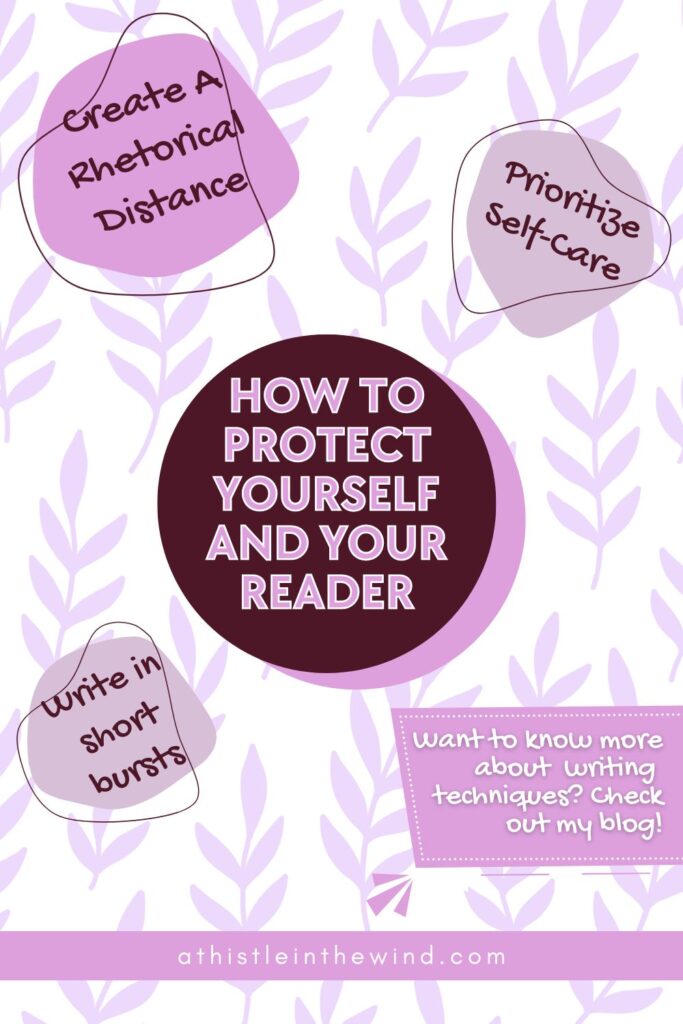
Avoiding Pitfalls and Stereotypes
Authentic trauma writing requires rigorous self-interrogation to ensure you are writing with clarity and compassion.
The Importance of Sensitivity and Research
It is critical to avoid assuming all survivors react in the same way, as trauma responses are highly individual. Some characters may withdraw, others might become hyper-alert, and some may appear outwardly unaffected while grappling with shame or self-doubt. Avoiding clichés respects the uniqueness of each survivor’s journey.
Careful research is essential to ensure that your depictions are respectful and grounded in real psychological responses. If you are writing about trauma, consider consulting sensitivity readers or mental health professionals.
Add content warnings if your story contains explicit depictions of trauma. It’s not censorship—it’s basic reader respect.
Let Your Characters Be Messy, Human, and Whole
Trauma shapes a person’s life, but it should not define anyone’s entire narrative. So, when you’re writing characters, you should let them exist beyond what they have endured. They deserve agency, contradiction, joy, and healing.
Ask yourself:
- Am I centering the survivor’s voice, or am I more invested in someone else’s reaction to their pain?.
- If I removed the traumatic event, would the character still have depth?.
- Is the pain necessary for the story, or is it there merely for shock value or aesthetic?.
- Who benefits from this portrayal? Is it serving communities and truth-telling, or is it leaning into spectacle or redemption arcs that centre the wrong person?.
The goal is to recognize the full truth of what it means to endure and keep living. By incorporating thoughtful perspectives and focusing on the path, you can create characters who are beautifully, imperfectly honest.
Remember, it’s challenging to write trauma. It requires effort and thought, but if the stories we are writing are not worth that effort, there is little point in writing them at all.
